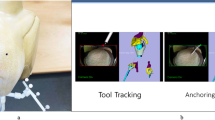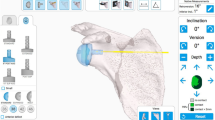Abstract
Purpose
Anchor placement on the glenoid rim is challenging with the angle of insertion critical to achieving satisfactory results. Incorrect anchor placement is a common problem.
Methods
Three plastic shoulder models were used. Reference markers were attached in the posterior portion of the acromion. Using the navigation system, reference point data from the glenoid were acquired. An anterior labral lesion of the glenoid was created that extended from the 1 o’clock to the 5 o’clock position. Three suture anchors were placed under arthroscopic guidance without the aid of navigation system (Group A) and with the aid of navigation system (Group B). Deviation from the optimal angle of 45° for anchor placement was measured and compared between the two groups.
Results
The mean insertion angles for anchor placement were 45.9° (SD 3.4°, 40.2°–50.4°) and 41.4° (SD 3.9°, 33.1°–47.6°) in the freehand (Group A) and navigated (Group B) groups, respectively. There was a statistically significant difference between the groups (P < 0.05). The mean deviation (from the optimal angle) was 4.2° (SD 3.2°, 0.0°–11.9°) and 2.8° (SD 2.2°, 0.2°–8.4°) in the freehand and navigated groups, respectively.
Conclusion
Navigation systems may improve the accuracy of glenoid anchor placement amongst low-volume shoulder surgeons. However, it does not provide any significant advantage over the freehand technique in a plastic shoulder model. Constant multiplanar visualization throughout anchor placement as facilitated by navigation made the procedure more manageable, even for an experienced surgeon.


Similar content being viewed by others
References
Bankart A (1938) The pathology and treatment of recurrent dislocation of the shoulder joint. Br J Surg 26:23–29
Blattert TR, Springwald J, Glasmacher S, Siekmann H, Josten C (2008) Computer-aided discectomy and corpectomy in anterior reconstruction of the injured thoracolumbar spine. A prospective, controlled clinical trial. Der Unfallchirurg 111:878–885
Fabbriciani C, Milano G, Demontis A, Fadda S, Ziranu F, Mulas PD (2004) Arthroscopic versus open treatment of Bankart lesion of the shoulder: a prospective randomized study. Arthroscopy 20:456–462
Kaar TK, Schenck RC Jr, Wirth MA, Rockwood CA Jr (2001) Complications of metallic suture anchors in shoulder surgery: A report of 8 cases. Arthroscopy 17:31–37
Kendoff D, Geerling J, Mahlke L, Citak M, Kfuri M Jr, Hufner T, Krettek C (2003) Navigated Iso-C(3D)-based drilling of a osteochondral lesion of the talus. Der Unfallchirurg 106:963–967
Khadem R, Yeh CC, Sadeghi-Tehrani M, Bax MR, Johnson JA, Welch JN, Wilkinson EP, Shahidi R (2000) Comparative tracking error analysis of five different optical tracking systems. Comput Aided Surg 5:98–107
Kim KC, Rhee KJ, Shin HD (2009) Arthroscopic three-point double-row repair for acute bony Bankart lesions. Knee Surg Sports Traumatol Arthrosc 17:102–106
Lehtinen JT, Tingart MJ, Apreleva M, Ticker JB, Warner JJ (2004) Variations in glenoid rim anatomy: implications regarding anchor insertion. Arthroscopy 20:175–178
Morgan RJ, Kuremsky MA, Peindl RD, Fleischli JE (2008) A biomechanical comparison of two suture anchor configurations for the repair of type II SLAP lesions subjected to a peel-back mechanism of failure. Arthroscopy 24:383–388
Page R, Bhatia DN (2010) Arthroscopic repair of a chondrolabral lesion associated with anterior glenohumeral dislocation. Knee Surg Sports Traumatol Arthrosc 18:1748–1751
Provencher MT, Verma N, Obopilwe E, Rincon LM, Tracy J, Romeo AA, Mazzocca A (2008) A biomechanical analysis of capsular plication versus anchor repair of the shoulder: can the labrum be used as a suture anchor? Arthroscopy 24:210–216
Rossouw DJ, McElroy BJ, Amis AA, Emery RJ (1997) A biomechanical evaluation of suture anchors in repair of the rotator cuff. J Bone Joint Surg Br 79:458–461
Sano T, Matsuoka H, Nakayama K (2009) Arthroscopic treatment of an anterior glenoid fracture with a cannulated, headless screw and suture anchors: a case report. Knee Surg Sports Traumatol Arthrosc 17:539–541
Sileo MJ, Lee SJ, Kremenic IJ, Orishimo K, Ben-Avi S, McHugh M, Nicholas SJ (2009) Biomechanical comparison of a knotless suture anchor with standard suture anchor in the repair of type II SLAP tears. Arthroscopy 25:348–354
Slabaugh MA, Friel NA, Wang VM, Cole BJ (2010) Restoring the labral height for treatment of Bankart lesions: a comparison of suture anchor constructs. Arthroscopy 26:587–591
Take Y, Yoneda M, Hayashida K, Nakagawa S, Mizuno N (2008) Enlargement of drill holes after use of a biodegradable suture anchor: quantitative study on consecutive postoperative radiographs. Arthroscopy 24:251–257
Tjardes T, Paffrath T, Baethis H, Shafizadeh S, Steinhausen E, Steinbuechel T, Rixen D, Bouillon B (2008) Computer assisted percutaneous placement of augmented iliosacral screws: a reasonable alternative to sacroplasty. Spine 33:1497–1500
Wong AS, Kokkalis ZT, Schmidt CC (2010) Proper insertion angle is essential to prevent intra-articular protrusion of a knotless suture anchor in shoulder rotator cuff repair. Arthroscopy 26:286–290
Zuckerman JD, Matsen FA III (1984) Complications about the glenohumeral joint related to the use of screws and staples. J Bone Joint Surg Am 66:175–180
Author information
Authors and Affiliations
Corresponding author
Rights and permissions
About this article
Cite this article
Koulalis, D., Kendoff, D., Citak, M. et al. Freehand versus navigated glenoid anchor positioning in anterior labral repair. Knee Surg Sports Traumatol Arthrosc 19, 1554–1557 (2011). https://doi.org/10.1007/s00167-010-1360-5
Received:
Accepted:
Published:
Issue Date:
DOI: https://doi.org/10.1007/s00167-010-1360-5




